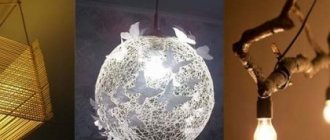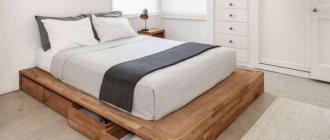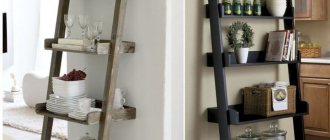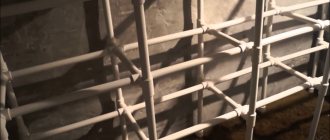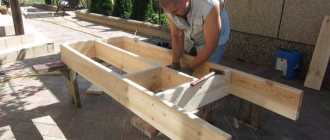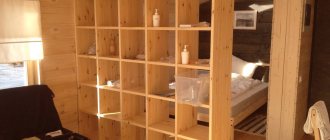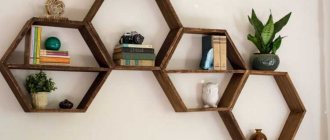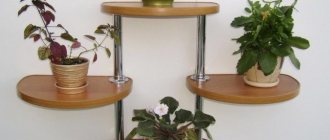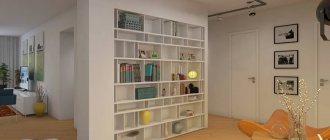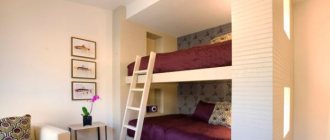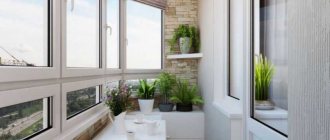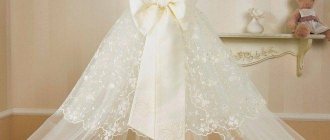For a child, as for any adult, a room has the meaning of personal space, where he feels like a little master. Accordingly, this tiny world must fulfill the individual needs of the baby. In the understanding of adults, it should be light, clean and spacious. For the baby, the most important thing is the atmosphere of the room, where he feels comfortable, first of all, with his favorite things. And each of them should have its own place. An option for storing toys, in addition to regular boxes, is a rack. Making it yourself means being able to provide all the child’s preferences.
Accordingly, this tiny world must fulfill the individual needs of the baby.
The benefits of creating a toy shelf with your own hands
Furniture made in a factory is devoid of individuality due to mass production. Production is on stream. Making your own items for storing toys has a number of advantages:
- ability to satisfy the most demanding requests;
- combination with the overall interior of the room;
- originality of execution;
- confidence in the quality of the materials used;
- convenience and functionality.
Making it yourself means being able to provide all the child’s preferences.
Classification of racks
With all their diversity in size and shape of structures, all racks can be divided into types:
- A stationary shelving unit made according to standards. The design is distinguished by its massiveness, confidence in its strength and inability to break under any weight. Such a rack cannot be moved to another place without partial disassembly to the frame of racks and the main load-bearing transverse boards.
- The design is easy to move due to additional wheels and the light weight of the material - this is a movable and mobile rack. With its help, you can change the perception of the interior by rearranging the room.
- An organizer rack for small and frequently used items, such as keys, will be convenient in the form of a pinwheel.
- In small areas, it is recommended to use a hanging rack. The design consists of several interconnected shelves. The space on the floor around it will be free.
Toy rack design and construction
It's hard to imagine a children's room without a shelving unit. From birth, it is able to perform the function of storing personal hygiene items. As the baby grows up, it begins to be used for its intended purpose. Toys, books, and construction sets appear on it.
For the baby, the most important thing is the atmosphere of the room, where he feels comfortable, first of all, with his favorite things.
The design and construction of a toy storage rack must be selected based on personal needs, as well as taking into account the following requirements:
- stability - the structure must have good support;
- safety - the absence of sharp corners and protruding parts will reduce the risk of injury to a minimum.
The simplest option for making children's furniture for storing toys is from fabric stretched over a frame or thick cardboard.
Depending on the age of the child, the toy storage system can be classified as follows.
- Up to 1 year - as a rule, at this age a baby has a minimum set of toys that can fit in one box or section with several shelves.
- From one to 6 years is the most active and inquisitive age, which is why the functionality of the children's room and the storage system for children's toys increases. There are a lot of items to play with and more space is needed to accommodate them to maintain order. In this case, an integrated approach to the issue is required: creating several boxes for storing toys that are interconnected.
- From 6 to 10 years is a transitional age for games. Some children continue to actively play with toys, others devote more and more time to studying and reading books. Accordingly, the role of furniture is changing. This can be a separate drawer or box for storing toys, or shelves that combine several tasks.
- After 10 years, there are usually a few favorite toys left that don’t take up much space. Functionality is directed to the placement of school supplies. It is most convenient to store them in a hanging cabinet, with open or closed shelves.
Depending on the type of rack, the materials and tools used in production will vary.
Depending on the gender of the children, the design of the children's toy rack will vary. For boys, it is preferable to choose more restrained tones in the design and keep decorations to a minimum. Furniture for girls should be more romantic, in bright colors, with a variety of decorations. However, the toy storage item must fit organically into the overall interior of the room.
Depending on the skills and abilities, it is possible to create an object from wood or rods, chipboards, plastic.
You can initially make a shelving unit for a children's room with your own hands in such a way that, as the child grows up, it will grow with him.
It is optimal to place niches along the free wall, which can gradually increase in number.
Among the variety of types of furniture with specific functions, single boxes, drawers, groups of boxes, ottomans, hanging shelves for storing children's toys and much more are distinguished for a children's room. It is optimal to place niches along the free wall, which can gradually increase in number.
For convenience, the toy rack is equipped with wheels and lids.
How to choose
Today, shelving structures are presented in a wide range, which greatly simplifies the selection of suitable furniture. First of all, you need to pay attention to the dimensions, configuration, style, design and required equipment and functionality.
Racks for toys made in the shape of trees, flowers, ships, houses or castles are small in size and have a bright design, but are suitable only for the little ones. Most likely, in a few years it will have to be replaced with a simpler and more down-to-earth design.
As a rack for books and stationery, it is better to choose combined school corners, where in addition to open shelves there are closed sections, as well as a desk.
The best option would be modular designs consisting of individual square or rectangular compartments of different sizes and colors.
Thus, the Expedit shelving unit from IKEA is a combination of identical cubes, and the Trufast line offers wooden frames with the ability to insert bright plastic storage containers into it.
In addition to the design, you also need to pay attention to the performance characteristics:
- A height that should be suitable for the height of the child.
- Depth of shelves.
- Reliability of fastenings and stability of the structure.
- Material (preferably wood, plywood, MDF or chipboard).
- Color and texture, of which light colors, bright geometric patterns or large-sized images are preferable.
- Safety and environmental friendliness, confirmed by the seller with special hygiene certificates.
It is highly not recommended to choose a shelving unit for a nursery only remotely by viewing photographs and reading the characteristics, since in such a case it is important to personally check the product and make sure of the reliability and strength of the structure.
Necessary materials
Depending on the type of rack, the materials and tools used in production will vary. Everything depends only on imagination. The simplest option for making children's furniture for storing toys is from fabric stretched over a frame or thick cardboard. This task will be feasible even for the mother of a baby. The choice of the fabric itself should be based on its ability to be durable and wear-resistant, i.e. have a tight weave of threads. These types include poplin, calico, satin, denim, as well as artificial leather and fur. Depending on the skills and abilities, it is possible to create an object from wood or rods, chipboards, plastic. For convenience, the toy rack is equipped with wheels and lids.
You can initially make a shelving unit for a children's room with your own hands in such a way that, as the child grows up, it will grow with him.
In addition to the basic materials you will need:
- glue – stationery, PVA, for gluing parts made of wood and plastic;
- colored paper and cardboard - for decorating the product;
- frame wire - for making fabric items;
- plywood - for the back walls.
Having decided on the type, design and construction of the toy storage rack, you need to make a sketch of it.
Options for using the rack
A wooden shelf will look great in a children's room. Open shelves will add a feeling of more space. You can store toys and many small household items on the shelves. This type of rack is characterized by the presence of a large number of identical open shelves, which can also be end-to-end. This design will fit into any interior.
The rack is convenient furniture for the office. Install it on the entire wall. The shelves should be different in height so that it is possible to place documentation in folders. Semi-closed design.
In the living room, the shelving unit performs a different function. With its help, the room is aesthetically decorated. Accessories and decorative items are placed on the shelves. These can be photos, indoor flowers, collection items.
In the kitchen, using a rack, you can organize a place to store dishes or various jars of seasonings and cereals.
Step-by-step production
Having decided on the type, design and construction of the toy storage rack, you need to make a sketch of it. Great artistic abilities are not required in this case. This can be simply a sketch on which the dimensions and overall dimensions will be noted. From these data the required amount of materials is calculated.
For an item consisting of three vertical shelves, you will need 1.3 m of fabric with a width of 1.5.
The production of a fabric variation does not involve the construction of special patterns and patterns; as a rule, markings, taking into account future sizes, are applied directly to the fabric.
Furniture for girls should be more romantic, in bright colors, with a variety of decorations.
For an item consisting of three vertical shelves, you will need 1.3 m of fabric with a width of 1.5. From the specified quantity, cut out and cut, taking into account seam allowances of 1.5-2 cm, elements of the following sizes:
- shelves – 4 pieces measuring 30*60 cm;
- side parts - 6 pieces measuring 30*30 cm;
- cardboard inserts – 4 pieces, size 28*28 cm;
- braid – 1 m.
The parts of the shelves are folded in half and stitched with a pocket, similar to a pillowcase.
The parts of the shelves are folded in half and stitched with a pocket, similar to a pillowcase. Then they are connected to each other by the side parts. Cardboard is inserted into the pockets to strengthen the bases. A braid is sewn onto the top of the finished structure and tied for hanging in the right place.
For boys, it is preferable to choose more restrained tones in the design and keep decorations to a minimum.
This type of rack is convenient because it is completely mobile, and the soft side walls, devoid of frame support, allow it to be folded like an accordion. The shelf is ideally placed in a closet if its purpose is to store children's supplies. Equipping the design with side pockets will provide additional storage space. This type will serve as a good alternative to a regular box.
A braid is sewn onto the top of the finished structure and tied for hanging in the right place.
Making a version from wood planks or chipboard will require more advanced skills, such as metalworking.
This type of rack is convenient because it is completely mobile, and the soft side walls, devoid of frame support, allow it to be folded like an accordion.
The manufacture of the frame begins with the walls: side, top and bottom. They are cut from laminated chipboard with a thickness of approximately 16 mm, according to the dimensions. Ordinary plywood is also perfect for the back wall.
Depending on the gender of the children, the design of the children's toy rack will vary.
The next step is making shelves with dividers. Rebates are cut out on the finished parts and grooves are made in the right places. The joints are glued with special wood glue and dried well. To ensure reliability of the structure, the elements are tightened from the inside with a metal angle. The boards must be provided with a good corner connection, which can be equipped with additional spikes and eyes. The sampling is performed with a chisel or chisel.
Making a version from wood planks or chipboard will require more advanced skills, such as metalworking.
Now you need to connect the shelves and vertical walls with nails and additionally glue them. The intermediate shelves are connected to each other with wooden pins. To do this, you need to make a through hole in the frame board, and drill sockets two-thirds the length of the pin in the shelves. They sit on glue. The back wall of plywood is nailed.
The design and construction of a toy storage rack must be chosen based on personal needs.
To equip a structure with drawers, it is important to accurately determine their dimensions. Installation takes place on special furniture casters.
According to psychologists, from early childhood a child must be taught order.
Finally, the finished structure is processed with sandpaper, the existing holes are filled with putty, and excess glue is removed.
And the evening collection of toys can be turned into a kind of ritual.
The wooden model is quite heavy, and therefore, in order to prevent falling and injury, it must be attached to the wall with a metal corner. In this way, sustainability will be ensured.
As the baby grows up, it begins to be used for its intended purpose.
Homemade children's shelves - ideas and master classes
Shelves in a children's room are additional storage space for books, toys, photo frames, souvenirs and other small items. They are good because they allow you not to hide all the most necessary and beautiful things, but, on the contrary, to display them for easy access and interior decoration.
- You can also make shelves easily and on a low budget with your own hands in literally 1 evening. In this case, you will have the opportunity to come up with an “exclusive design” that the baby will like and fit perfectly into the interior of the nursery.
For creative parents, we have prepared a large selection of ideas and inspiring photos, as well as a master class on making a homemade shelf in 7 steps.
6 DIY Shelf Design Ideas
Idea 1. Curly shelves
Curly shelves may not be the most practical and functional, but they are definitely the most beautiful and fun. They are made easily and quickly. The main thing here is to show your imagination and... have a jigsaw.
- We will tell you more about making such a shelf in step-by-step instructions at the end of the article.
- You can search for ready-made figured shelves on Etsy.com or the Crafts Fair.
Here are original and easy to implement ideas for a homemade floor shelf for books and toys.
A video tutorial from the Do It Sam channel will help you make a similar floor or wall-mounted children's book shelf, where a master makes a shelf in the shape of a sheep with several sections out of plywood.
Idea 2. Hanging houses for toys
Wooden toy houses have long been a hit in modern children's interiors. You can make them from thin plywood yourself or order them from crafts moms on Instagram or Etsy.com.
However, toys can live not only in houses, but also in such sections and cells as in the photo below.
Idea 3. Hanging shelves for toys and decor
Another fashion trend is planks or boxes suspended on ropes or ropes from hooks. As you can see, the design of hanging shelves is simple and can be done very quickly.
Idea 4. Use available materials
Shelves can be made not only from plywood, chipboard, MDF or wood, but also from pallets, boxes, cardboard boxes, old chests, skateboards and other scrap materials. We present examples of such shelves in the following photo selection.
You can watch how to make a shelf from a pallet with your own hands in this video master class:
Idea 4. Shelves with hooks
Shelves with hooks for hanging clothes are a more functional and practical solution. Such a shelf would be especially relevant in a newborn baby’s room, because it can be installed above/near the changing table, then all the most necessary things will always be at hand for the mother. You can make a hanger shelf with your own hands by simply screwing the hooks on the back of the board to the board.
Idea 5. Involve angles
To make the most of a small space, you should choose corner shelves for storing books and toys. You can make them with your own hands from a triangle or a quarter of a circle (from the selected material) and a pair of brackets, or form a corner from two adjacent shelves.
Idea 6. Narrow slats for a children's library
Do you want to instill in your child an interest in reading? Narrow slats will help you with this, on which you can display books not with their ends, but with their covers forward. Then the bright library will always attract the attention of the young reader and at the same time decorate the walls of the children's room.
- It’s not difficult to make such a ledge for books with your own hands; to do this, you need to construct it from three narrow boards - a support, the shelf itself and the side. To make the plank more beautiful, you can decorate it with ceiling molding. By the way, some types of moldings themselves may well become shelves after a simple alteration.
However, the slats are intended not only for books, but also for storing icons, decor, paintings or photo frames.
Master class - how to make and hang a children's shelf
To work you will need:
- Plywood with a thickness of at least 15 mm or wooden boards made of soft wood, such as pine.
- Brackets, for example, are made of untreated wood, which are sold at Ikea or any hardware store. When purchasing brackets, be sure to check the permissible load weight for them.
- Also prepare screws with dowels, a drill or hammer drill with a drill (the tool must match the wall), a building level, clamps, a pencil, and paintwork with a brush.
Step 1. Draw a silhouette of the mountains on one board, and make markings for cutting on the other.
Step 2. Secure the boards to the table with clamps. To avoid leaving traces of clamps on the wood between the board and the clamp, you can lay fabric. Then we cut out our “mountains” with a jigsaw exactly along the marked lines, and also cut out the shelf itself.
Step 3. Carefully process the material with sandpaper along the ends and, if necessary, over the entire surface.
Step 4. The next stage is assembling the structure. We attach the “mountains” to the shelf (on the reverse side) with nails, self-tapping screws or self-tapping screws. It is advisable to do this in such a way that the fastening points can later be hidden by brackets.
Step 5. Now you need to paint it with two layers of paint or cover it with matte acrylic varnish.
Step 6. While the workpiece is drying, you can begin attaching the brackets. To do this, you first need to make sure that there is no electrical wiring in the desired location, then you need to draw markings on the wall using a building level and mark the fastening points.
- Before work, do not forget to lay a rag or newspaper on the floor so as not to get the floor too dirty. It’s even better to use a special dust collector for a rotary hammer or simply stick the bag on masking tape under the drilling site.
Then we take the following steps:
- We use a center punch to punch a hole at the attachment point as shown in the photo below. This is necessary so that when you start drilling, the drill stays exactly in the center and does not move.
- Using a hammer drill, we drill holes in the wall to a depth slightly greater than the length of the dowel (taking into account the dust that will remain in the hole). Keep in mind that the thickness of the drill should be slightly larger than the diameter of the dowel, and the dowel itself should be selected based on the expected load on the future shelf (a consultant in the store will definitely help you choose the appropriate option). You need to drill the wall strictly horizontally or slightly from top to bottom.
- Insert dowels into the resulting holes. Next, holding the brackets in place, fasten the screws.
Step 7. Hooray, almost done! All that remains is to secure our workpiece (with the paint/varnish already completely dried) to the bracket. To do this, simply place it on the corners and screw it onto the screws from below. Of course, they should be of such length as not to extend onto the front side of the product. Well, that’s all, we check our shelf for reliability and evenness and hurry to put something on it.
(Rate the material! Already voted: 21 average rating: 4.81 out of 5)
Decoration
Depending on who the children's toy storage rack is intended for - a boy or a girl, as well as the interior of the room, its decor is also carried out. But, despite all the strict rules, it should give the baby a feeling of joy and comfort. Any option can be combined with decorative elements such as butterflies, flowers, bows, cars or fairy-tale characters. They can be made of fabric or special paper and glued to the finished product. It can also be a ready-made decorative element purchased in a store.
- The finished wooden product, after finishing work, can be painted in the required color and varnished in the desired shade.
- Drawer fronts can be made directly using colored chipboard.
- The installation of melamine edging works well as a decoration. To do this, it must be applied to the end parts and ironed with a hot iron. After it is firmly fixed, the residues are removed with a knife. Another type of design is installing a baguette. This will make the rack look neater and more interesting.
- An interesting option would be to invite your child to decorate his children's bookcase himself.
It's hard to imagine a children's room without a shelving unit.
According to psychologists, from early childhood a child must be taught order. And this, in turn, is the baby’s personal belongings and toys laid out and placed in their places, forming a single storage system. Having a separate place will also be useful if a small family member does not have his own children's room. And the evening collection of toys can be turned into a kind of ritual.
Furniture made in a factory is devoid of individuality due to mass production.
Having a separate place will also be useful if a small family member does not have his own children's room.
Unusual shelving design ideas
A rack of 3 shelves and 12 bottles instead of side boards will look extraordinary. Starting from the base, drill holes on both sides that will correspond to the bottom of the bottle (2 holes on each side).
Holes for the neck are drilled in the board that will be higher. Bottles are inserted and the shelves are connected to each other. The next shelf sits on the rail using self-tapping screws. First, you will need to make holes in it for the bottom of the bottles.
Made by hand. With love
Kucher's Life is a story about a young family who loves handmade things. We strive to create our own cozy design, give old things a new look, and teach children to appreciate handicraft. To captivate others with our ideas, we write articles and master classes. You can read more about us here.
Is it possible to make furniture from cardboard?
You can make furniture out of cardboard. But not from everything. Thick packaging cardboard is suitable, from which boxes are made for televisions, refrigerators, countertops, prefabricated cabinets and other large household appliances and furniture. Thinner material can either be glued together in several layers, or reinforced with stiffeners made from accordion-folded strips of cardboard.
If you have cardboard boxes, you will only have to purchase paint and glue.
The most suitable packaging corrugated cardboard for our purposes is a sheet material consisting of five layers: three parallel sheets of ordinary cardboard, between which two corrugated sheets are glued with starch glue.
By following certain rules for processing the material, cardboard interior items will be very durable and will not bend under the load of objects.
How to assemble and how to paint a plywood house shelf for dolls?
Assembling furniture from plywood with your own hands has its own specifics, but is not much different from the standard methods used for furniture panels. Most often, craftsmen use furniture dowels for internal fastening with gluing. It is not as fast as assembly with self-tapping screws, since you need to wait for the glue to dry. But more accurate.
The accuracy of gluing and the process itself will speed up the use of clamps. With their help, you can clamp the parts in the desired position until the glue dries completely.
If you planned to paint your own plywood doll house in different colors, then it is better to do this before gluing. Water-based paints and varnishes are used for coloring; they are absolutely non-toxic and safe for use in children's rooms. These can be acrylic paints that can be mixed. Before painting, the surface of the shelf parts must be sanded, sanded and primed so that the paint applies evenly.
How to reliably strengthen a structure
We made a rack of boxes with our own hands, but will it be strong and reliable enough? You can strengthen the structure in different ways. For example:
- Make double walls by gluing two or three sheets of thick cardboard.
- Reinforce the walls with stiffeners made from accordion-folded cardboard strips.
- Make a lattice structure from slats and attach it to the back of the rack.
By showing your imagination and creativity to the fullest, you will create a unique interior masterpiece that will be admired by your family and guests at your home.
More complex designs can be made from cardboard, with shaped elements, themed decor and fittings. In most cases, you will have to draw a sketch and drawing, take measurements and think through each stage of making furniture with your own hands.
Don’t be afraid to experiment, keep up with the times, because cardboard furniture is not only affordable, but also an original option for creating comfort and a unique atmosphere.
